The Sofitel Hotel once stood on the Ueno park skyline like a bizarrely massive chest of drawers, at once a paean to modern design aesthetics and traditional Shinto values. It was demolished in December 2006 after only 12 years of offering 83 4-star rooms in central Tokyo, leaving a weirdly-shaped gap on the city-scape viewed from Shinobazu pond. Like the cherry blossoms that frame so many shots of the Sofitel, it was only a temporary beauty, one that serves to remind us of the short time we`re here, and how any one of us can be called away at any moment.
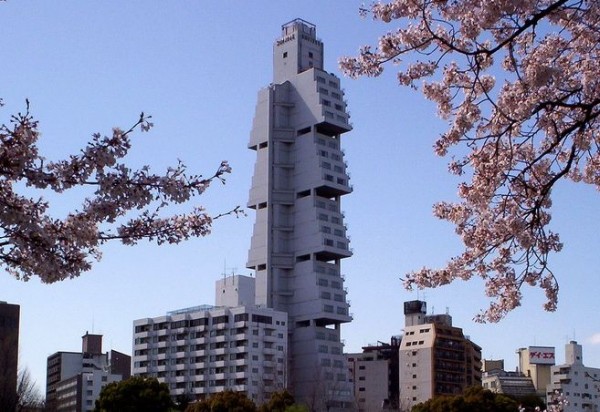
The Sofitel and Cherry Blossoms. Thanks to sevargmt for this image.
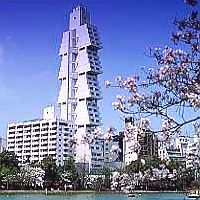 Described by Frommers as `an oasis of refined beauty, excellent service, and great views`, and by PassionAsia as `occupying Tokyo’s best location`, you have to wonder why the Sofitel failed. It was completely refurbished in 2000, only 8 years after it was first built- and surely yet to recoup it`s building cost. Its suites on the 25th floor cost ï¿¥58,000, with singles and doubles on the lower floors the still pricey ï¿¥30,000 and ï¿¥40,000 respectively. It boasted such amenities as TV`s with internet-viewing capacity (no email though…), irons and ironing boards, concierge center, fitness centre, French restaurant Provence with real-life French chef, and more. What went wrong?
Described by Frommers as `an oasis of refined beauty, excellent service, and great views`, and by PassionAsia as `occupying Tokyo’s best location`, you have to wonder why the Sofitel failed. It was completely refurbished in 2000, only 8 years after it was first built- and surely yet to recoup it`s building cost. Its suites on the 25th floor cost ï¿¥58,000, with singles and doubles on the lower floors the still pricey ï¿¥30,000 and ï¿¥40,000 respectively. It boasted such amenities as TV`s with internet-viewing capacity (no email though…), irons and ironing boards, concierge center, fitness centre, French restaurant Provence with real-life French chef, and more. What went wrong?
Perhaps it was swallowed in a mountain of debt, perhaps high-class esecutives thought its architecture too ridiculous, or perhaps its location was not so great, its management awful, or organized crime ran it into the ground with pay-offs. I don’t know the answer, but whatever the case, now it`s only a fading memory.
Designed by the architect Kiyonori Kikutake as a series of 5 stacked trapezoids, it was intended to embody the Shinto concept of the `Tree of Life`, a lightning-bolt-shaped cut of white zig-zag cloth tied around the thick boles of ancient trees.

This `tree of life` symbol is prevalent in all Shinto shrines around Japan, both tied around trees like lightning bolt charm bracelets, and hanging like Christmas decorations from a shrine`s heavy eaves. The bolt chiefly honors the trees, which are viewed as sacred- an idea reinforced in traditional Japanese art, where dead ancestors are represented as branches on the tree of life.
I first saw the Sofitel in my first year in Japan, 5 years ago, no doubt on a trip with my then-girlfriend. We would have looked at it and wondered – `what the heck is that?`. She`d been a student in a Tokyo University for several years, but didn`t recognize the hotel. Now, 5 year later, I went back to Ueno with a new girlfriend, a new life and job and home in back of me, purposefully looking for the Sofitel for my Structures series. But, of course, it was gone. All things pass, I guess, and time waits for no man.
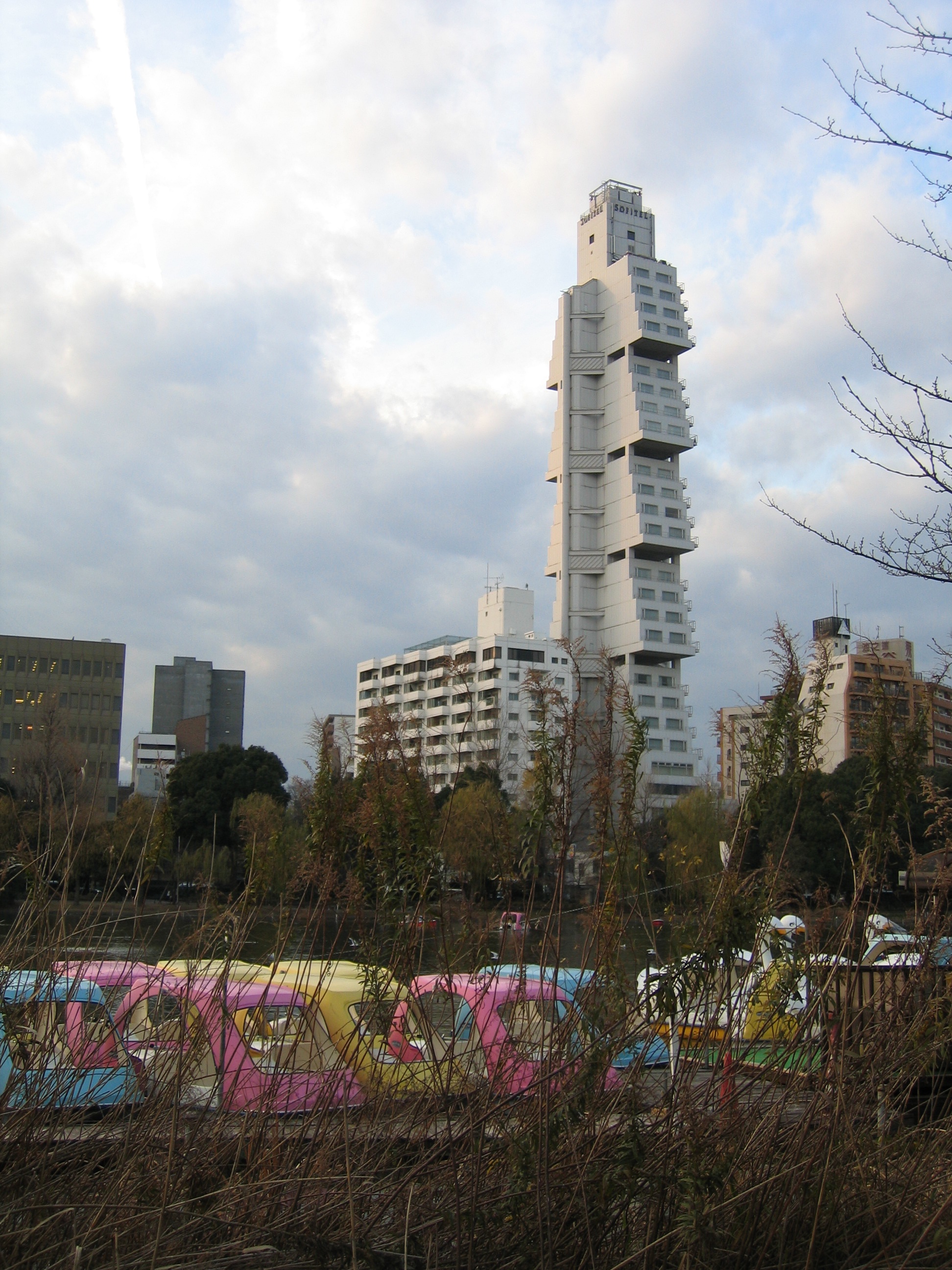
My friend Bruno`s shot of the Sofitel- another reminder of the impermanence of things, especially in a city of transients like Tokyo. Bruno was here for a few years, now he`s back in Canada close to completing a Law degree. He sent me this shot of the Sofitel unbidden, starting me off thinking about putting up a post of aggregated photos. Thanks Bruno!
.

My good friend Jason Collin`s photo of the Sofitel- Jason is yet another person leaving, in the next few weeks, after 5 years in Tokyo- headed back to the States with his Japanese wife. Good luck, Jason!
.

Twin Towers over Shinobazu pond- thanks to Naotakem for this image.
.

Beautiful crisp shot looking up the Sofitel- thanks to Caspar B. for this image.
.

A panorama by Jason.
.
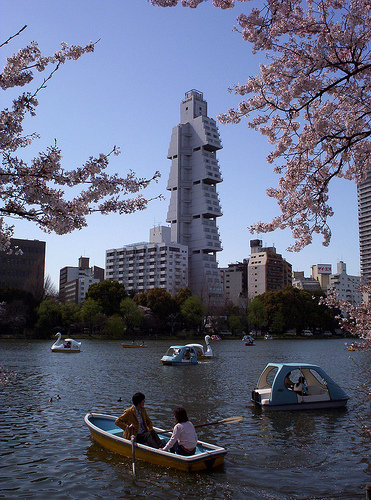
The Sofitel and cherry blossom over Shinobazu pond. Thanks to sevargmt for this image.
.

The Sofitel by night, looking up. Thanks to ataq411 for this image.
.
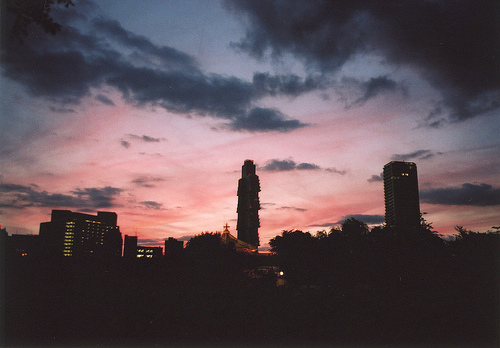
Gorgeous dusk shot- thanks to Fui for this image.
.
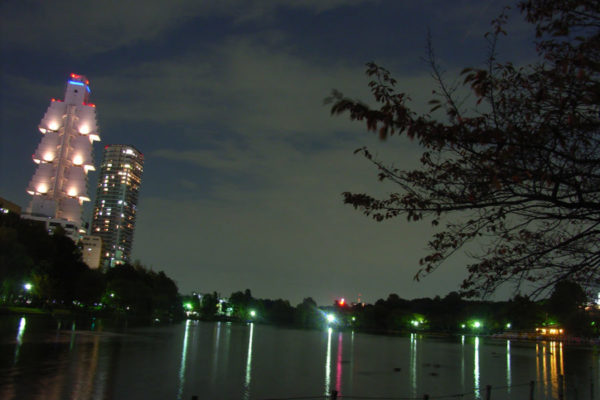
The Sofitel by night, looking across the pond. Thanks to ataq411 for this image.
.

The Sofitel from space- thanks to Googlemaps for this image.
.
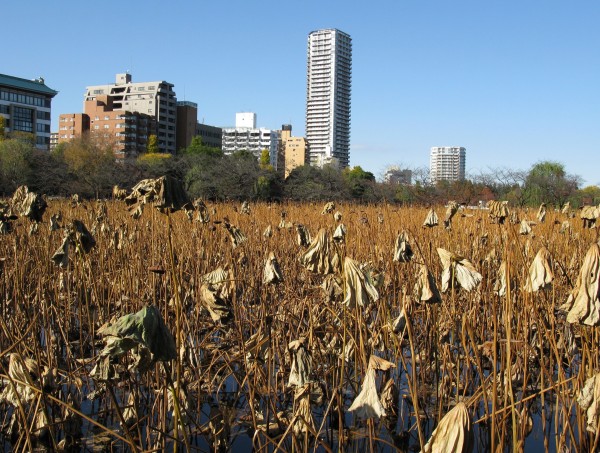
My only shot in this series, the current view over Shinobazu pond, with no Sofitel in sight.
FACTFILE
Location – Ueno, Tokyo
Entry – No chance, it`s gone.
Facts – Completed in 1994, refurbished 8 years later in 2000, demolished only 6 years after in 2006.
Architect – Kiyonori Kikutake, the same guy who built the similarly trapezoidal Edo-Tokyo Museum in Ryogoku.
Highlights – Memories of seeing it and thinking- `what the heck is that?`, thoughts of `mono no aware` or `the sadnes of being human’- the impermanence of things.
TOKYO
You can see all MJG’s Tokyo content here:
[album id=5 template=compact]

Comments 18
I just remembered that two friends from the U.S. that you met before, Steve and Anna, stayed in that hotel on one of their visits to Japan. They may have some photos of the insides even.
Too bad they took that hotel down.
Glad I randomly had photos that could be used in the post. I have recently heard this type of thing be called a “Lewinsky” in photography lingo. It means that you should never delete photos, even not so great ones, because you never know when someday something or someone you may have captured could make the photo valuable.
Thanks for this article. Great memories. Yes, too bad they took it down but – after all – this is not only the country where the transience of things is celebrated [wabi sabi]. But, always worth remembering when it comes to architecture, this is the country/city that tore down a Frank Lloyd Wright, in the form of the Old Imperial Hotel. It survived the 1923 quake. It survived WW2. It did not survive the construction state mentality, however. If you can tear down a FLW, you can tear down anything.
I’m surprised it was torn down. Even if the hotel failed, it was relatively new. If the rooms were large enough, maybe it could have been converted to apartments.
One of my friend had the experience with this hotel.He was telling me about his experience.I got excited.I should go once.
Time files and things change. I remember I saw the unique building(I didn’t know it was even a hotel.) with pedaling the duck boat 3 years ago. Shame that it is gone now.
so sad, i stayed at this hotel in feb 2006, 10 months before it was torn to the ground. I have fab memories of it. It stood right next to the zoo and park. I have great pics from my room window of mt fuji. those pics alone are worth the room rate. i cant believe its away. how disappointing.
nicola (glasgow, scotland)
on the latest shot from Michael, it seems the pond has… overgrown! *pond ?haikyo*
Author
It is a shame they tore it down, but I don’t think any of us would have them keep it up if it wasn’t making a profit. Wabisabi is part of it for sure, but there’s also just plain reality. Things that fail should be allowed to fail (AIG!). Converting to apartments Tornadoes I guess was not-profitable either.
nicola Houston and a student in York, thanks for sharing your memories of staying there- it must’ve been a great view over Ueno. SY thanks for sharing your experience- I didn’t know it was a hotel either when I first saw it.
Alfie you make a great point about the Imperial Hotel- I did a little checking on that though and it seems there are contrasting reports on the demolition, some stating that it wasn’t a fickle tearing down but actually quite a necessary one. The Imperial was structurally damaged by the earthquake and wasn’t sound to stand- they had to destroy it. Who knows really, but I imagine there was some of that even if it’s not wholly true.
Jason thanks again for sharing those photos.
Finally, isuna you have a very good point, probably I should head down there again and explore the pond.
You can see part of the FLW Imperial Hotel – entrance and lobby w/repro furniture and dishes – was moved to Meiji Mura in Inuyama, Aichi. It’s easier to get there on Meitetsu (shuttle buses to/from the station) than JR (might have to take the Takayama honsen, IIRC).
I stayed in this hotel twice in 2002, it was such a great experience. The rooms were great, bathrooms were huge with walk in showers. They had the Toto “self-cleaning” toilets and the whole place emphasized the whole Japan “experience” of mixing modern and traditional design. The location was great, just a small walk from the rail station and I’m sad to learn that it is not there. I’ve been itching to get back to Japan for a visit and quickly looked up this hotel on the Sofitel web site when I could not find it I Google’d “sofitel ueno hotel” and found this page.
Thanks for the update.
I was stunned the day before yesterday to walk through Ueno Park with some friends and, turning to point out the staggering Sofitel Ueno where I spent a very memorable visit, found just a blank space. I thought I was hallucinating – where could a 26-story hotel go? Michael, if you send your email address to me I will send you some panoramic shots of the view from the 22nd floor which you can add to your gallery. Sigh. How could they tear down such an iconic building?
Nice to see your article and photos. I lived in Tokyo in the late 90s and occasionally wondered what the building was. I then returned in December 2005 and stayed one night there as it was handy to get the train direct to Narita airport. Great views, nice rooms and rather good value – perhaps they were trying to get more customers in.
I was stationed at N.A.F. Atsugi, Japan from 1997 until Jan 2002. In early 2001 My sister came out to spend a week with me. We stayed 1 night (actually I left her there and went to visit a lady friend in Shinjuku) at the
Ueno Sofitel. The night before this we climbed Mt.Fujisawa (a misadventure in itself) with the goal of reaching the sumit in time to see the sunrise. We got back to Atsugi then took the trains to Tokyo and ended up at the Society to visit Ueno park / zoo the next morning. It was my sister’s first encounter with a Japanese computerized you let seat (heated, fan for drying the backside, automatic lifting up & down of the seat, etc.) somehow the seat heater got left on and she burned her bottom early the next morning. Luckily not too badly. But it was an awesome room with an awesome view.
This building means so much to me as an example of a fearless design – sorry it’s not there any more.
When I firsy encountered it across the pond in Ueno Koen in 1998 it mesmerised me – ‘what is that?’ its so unusual, surprising, modern – yet not western. Frames the Ueno Koen like it might as well be a giant pair of ‘oHashi’ A truly beautiful building – inspiring.
Just returned from a trip to Tokyo. My hotel was in the Shimbashi/Ginza area so I made the 10 minute walk over to another endangered Tokyo piece of architecture… the Nakagin Capsule tower. Sadly, it’s days are numbered too. Can’t get the Bladerunner-esq images out of my head. So… I fell into the internet hole and stumbled across your photos of this hotel. I too saw it from the back of Ueno Park years ago and thought what the hell is that? And… how freaking cool that there are buildings that interesting in Tokyo. I had no idea that it was torn down within a year of me seeing it on that first trip so many years ago. Thanks for helping me to remember.
I stayed in this hotel for 3 nights many years ago and I am still haunted by the huge B/W period photo of an incredibly beautiful Japanese woman in the lift. Does anyone remember this or know who she was?
I also had the pleasure of staying in this hotel on a business trip in 2003. I also took photos of it, but unfortunately I can no longer find the pictures.
Today I tried again to find the hotel via Google Maps, surprisingly enough that after more than 20 years I knew exactly where to look.
unfortunately I didn’t find it. At the same time, I found a China travel report of mine raving about the Sofitel in Tokyo. I finally knew the name again, unfortunately Google Maps broke my heart.
So I would like to say a big thank you to you and your blog. I never realized how famous this hotel was! really such a shame.